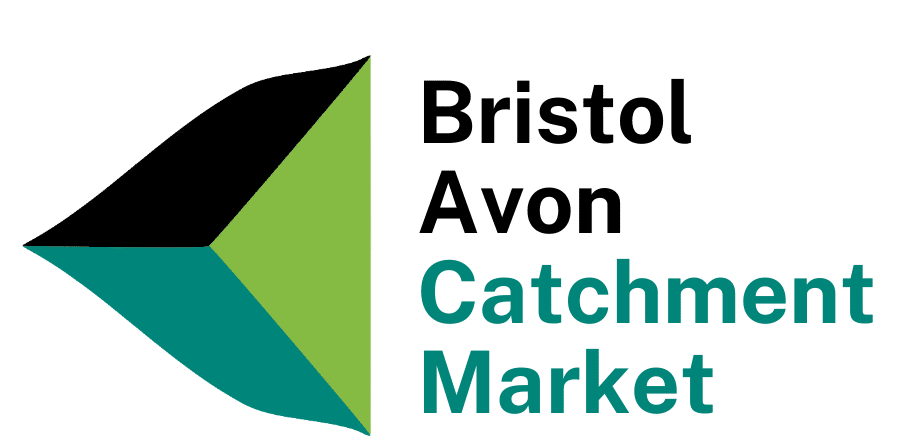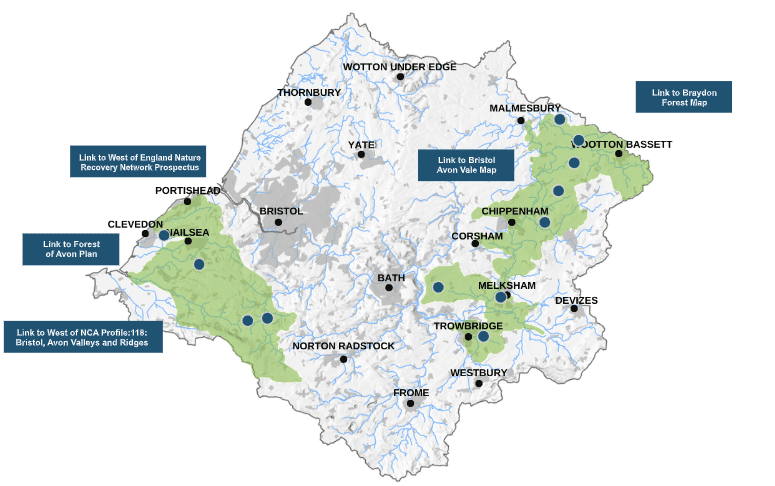Project Overview
The Bristol Avon Catchment Market is an online marketplace for buying and selling local and verified environmental services, including biodiversity, carbon reduction and natural flood management.
The project is being delivered through a collaboration between Avon Wildlife Trust, Wiltshire Wildlife Trust and EnTrade (the BACM team). It is working with landholders and buyers of credits (such as developers) across the catchment to deliver a pipeline of projects and generate fair prices for environmental services. This will be done through a user-friendly trading platform that operates in ‘Market Rounds’ that aggregate buyers and seller offerings within set timeframes.
Acknowledgements
With many thanks for their time and insight on this case study:
Chelsie Fuge, Team Manager, Bristol Avon Catchment Market
Amy Coulthard, Director of Operations, EnTrade
Rebecca Burville, Operations Manager, Entrade
Date published: 11/05/2023
Project Mandate
The Bristol Avon Catchment Market (BACM) project aims to reverse the loss of biodiversity and nature that has affected the catchment, reflective of the loss across the UK. In the UK, 15% of species are facing extinction and the abundance of priority species has declined by 60% since 1970.
In the Bristol Avon Catchment, key challenges include high phosphate levels, high sediment loading, flooding and reduced natural habitat and biodiversity. There is also significant new housing and development planned for the area. For example, there is a target for over 20,000 new homes in North Somerset over the next 15 years.
The Avon Wildlife Trust, Wiltshire Wildlife Trust and EnTrade (a subsidiary of Wessex Water) came together in order to pioneer a ‘catchment market approach’. These organisations have historically been working together on environmental issues through the Bristol Avon Catchment Partnership, but decided to adopt this holistic approach that would allow multiple environmental services to be delivered across the catchment.
Catchment markets reward land managers for the multiple ecosystem services delivered by nature-based projects, and offer buyers verifiable environmental credits. The approach uses an online platform and a unique market settlement mechanism, designed by the University of Exeter, to efficiently match supply and demand, and aggregate local projects to substantially reduce the transaction costs to buyers and sellers of contracting for the environmental goods and services delivered. It is one of three Catchment Markets currently being developed in England.
Developing a New Market Concept
The concept of a ‘Catchment Market’ was developed by the Broadway Initiative, outlined in a publication in July 2020, and further guided by the Strategic Directions report of the Financing Nature Recovery Coalition (FNRC) – led by the Broadway Initiative, Green Finance Institute and Finance Earth. This report sets out the high-level principles of High Integrity Environmental Markets, such as standards and accreditation, good data, aligned incentives and regulation, and clear market rules for participants.
Several experts were brought in from different areas of expertise, to establish the concept of a Catchment Market.
The market settlement process has been designed by experts from the Land, Environment, Economics and Policy Institute at the University of Exeter (UoE). Key to this process is the Lindsay Mechanism (named after Dr Luke Lindsay of the UoE), which ensures payments are fair both for project suppliers and those buying environmental credits.
Amy Coulthard, Director of Operations at EnTrade explained that EnTrade brought key knowledge and infrastructure, as their core mission centres, working with multiple farmers and landholders to develop and provide accreditation for projects, that can deliver ecosystem services. When started in 2015 by Wessex Water, EnTrade focused solely on single-ecosystem service deals, such as nitrogen and phosphorus reduction schemes where Wessex Water acted as the primary buyer. However, EnTrade has since broadened its focus to include multi-benefit auctions and the Catchment Markets. Since 2015, EnTrade has been gathering data on environmental auction behaviour, and has built an online trading platform that facilitates the bidding and price settlement process.
Other experts and key design stakeholders include Wheatley Young Partners, which worked with EnTrade to develop the Catchment Market High Level Design, Market Rules, legal framework and other Market Instruments. The Legal Agreements were developed by EnTrade working with Wheatley Young Partners and with legal expertise provided by Wessex Water and Osbourne Clarke.
Over eight years, this group have designed and built core components of the ‘Catchment Market’ concept, including the central role of the Market Operator (in the case of BACM; EnTrade), the Market Rules of participation, the standards and accreditation processes, and the contract mechanisms. These have been aligned with the FNRC’s recommendations for high-integrity markets for nature.
A brief video of the market structure can be found below.
Curating a connected landscape
The Bristol Avon Catchment comprises an area of 2810km² and drains parts of Gloucestershire, Wiltshire and Somerset.
To first understand what nature restoration and habitat creation was needed across the catchment, the BACM team pooled their datasets and previous research findings. These datasets are largely public, including Wessex Water’s Water Efficiency Management Plan (WEMP) that has nature recovery mapping within the catchment. The data included estimated land values, agricultural land classification, nutrient mitigation issues, and soil profiles, among other data points. This gave a clear indication of ‘priority areas’ across the catchment (shown as green in the map below), and quantified targets of what the BACM team hope the market will deliver in its first round, including:
- 58 hectares of species rich grassland
- 65 hectares of new woodland
- Five hectares of wetland
Chelsie Fuge, Bristol Avon Catchment Market Manager, says that the WEMP dataset was a key asset to curating a connected landscape. However, the BACM team understood that the priority areas would only be as useful in understanding where nature restoration is most preferred, as the market pilot relies on a more ‘organic’ journey where landholders (sellers) would volunteer their sites as projects. Given this, the team agreed that while sites in these areas would be prioritised in the screening stage of the market, landholdings across the catchment would be eligible.
The type of landholder is similarly unrestricted, including tenant and owner-occupied farmers, estate owners, companies and local authorities. Land agents, advisors and other intermediaries could also submit projects to the market on the landholders’ behalf. Sites were carefully screened for opportunities and constraints.
However, the team were conscious of attracting sellers that were genuinely interested in improving their natural capital and already using best practices in land management. After analysing the data, the team went into a detailed desk-based study of existing landholder projects, assessing a wide range of land features, from historic environmental records through to proximity of notable or protected species, habitats, soil types, topography and more. The Wildlife Trusts’ existing knowledge base and network was helpful in pulling together this insight, informing the BACM team of what sellers it wanted to attract to the BACM. In turn, this work informed the design of the project screening stage. Reflecting on this work, Fuge says the team found that including desk-based studies yielded better results than solely relying on the data and enabled crucial consideration toward other landscape considerations.
Overall, initial project scoping was a relatively quick process, reliant upon more detailed assessment further down the line when individual landholders registered their interest, with more specific locations in mind. Scoping is also made far more efficient by the availability of supporting guidance, including Nature Recovery Network mapping or habitat opportunity mapping, such as provided by Forestry Commission (Forestry Commission Map Browser (forestergis.com)).
Funding Project Development
The BACM team initially began scoping this project in 2020, and received £1.7m of funding in 2021 from the Government’s Green Recovery Challenge Fund (GRCF), which is aimed at environmental charities and their partners to start work on projects across England to restore nature and tackle climate change.
The BACM also uses EnTrade’s online trading platform, which is being used across the three catchment pilots and represents investment from Wessex Water of more than £1 million.
The market has been designed to become a self-sustaining process, not to generate a profit but to cover market operation fees and a revolving fund to support nature’s recovery. Project establishment costs will be supported by the GRCF to kickstart this process, generating a surplus of finance for future market rounds.
To date, pre-market settlement, the projects greatest expenditure has been on staffing and external consultants/specialists directly associated with the development of new concepts and at a time when much of the key government policy and guidance was still in development.
Key Learnings
The BACM and Entrade teams offer the below learnings for other project developers:
- A pipeline of projects for emerging markets takes time to develop and landholders will be wary of entering agreements whilst ambiguity remains e.g. tax implications of selling environmental services
- Legal Agreements are resource intensive and it is important to balance the needs of both sides of the market and manage risks and liabilities for all market participants including the Market Operator
- Many stakeholders remain sceptical about the role markets and private investment can play in nature recovery projects which impacts on engagement and can lead to misconceptions. Stakeholder engagement is a key element of market development.
- Robust standards and standardisation of as many aspects as possible can make project development more efficient but there remains a need for flexibility to account for location specific circumstances.
- Mapping and targeting key areas or landscape features is good practice and may be a requirement for some environmental services e.g. Nutrient Reduction Credits, but should not become a barrier to participation; with new concepts, participation is key to benefit from the exploration and learnings that individual cases present.
- Don’t underestimate the amount of time required for raising awareness, marketing and communications; new concepts, particularly complex one’s, take time to understand and become known through engagement.
- Working closely and openly with other stakeholders, such as local authorities, is key when working across boundaries and disciplines.
- Additional specialist support is likely to be required, including legal, ecological, and financial expertise.




